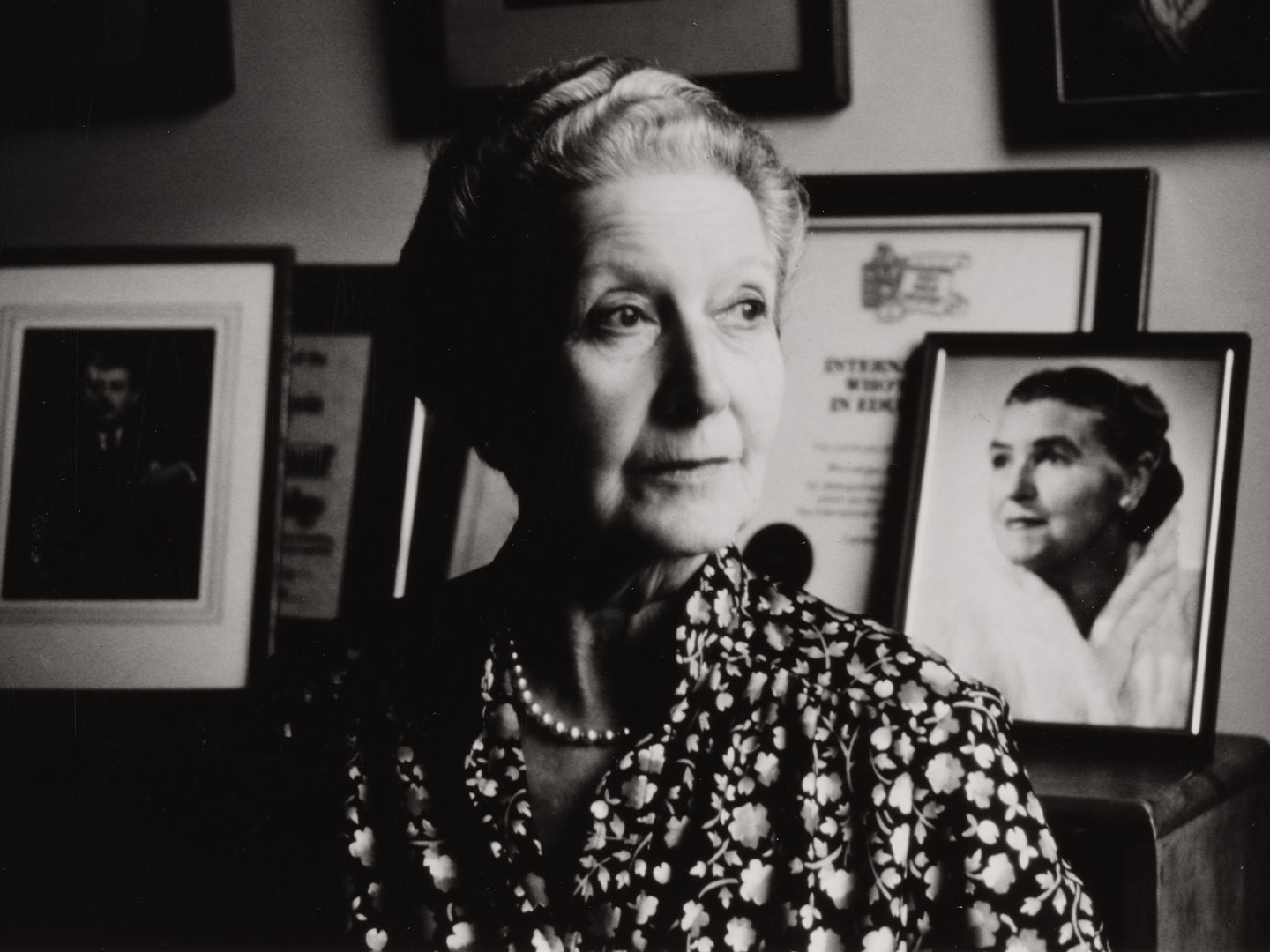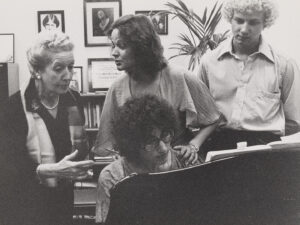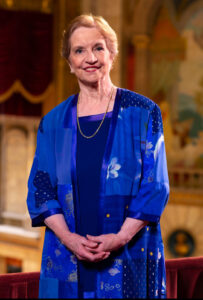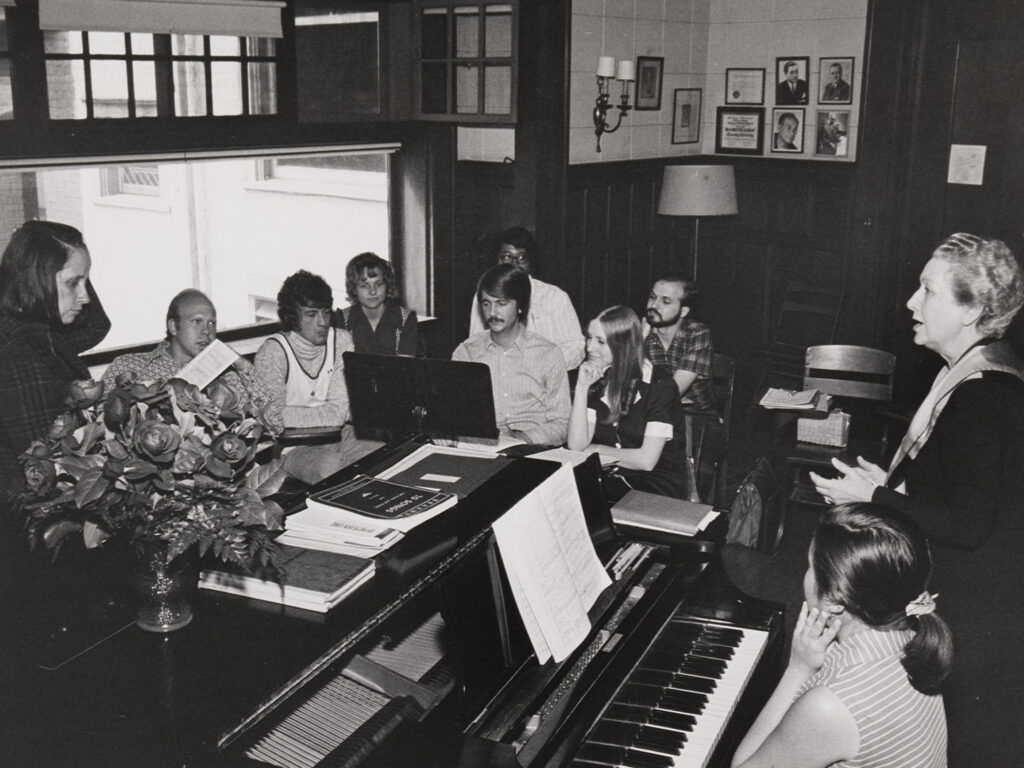
Collaborating Across Generations
By Julie Riggott
Pioneering women in the Keyboard Collaborative Arts program spotlight the innovative nature of USC Thornton.
The USC Thornton School of Music has a long history of innovation, beginning with its inception as the first professional school at USC in 1884. The oldest continually operating cultural institution in Los Angeles, USC Thornton has long been considered among the most prestigious music schools and conservatories in the nation — in part because it has never stopped innovating. Keeping in rhythm with an ever-changing industry, it has introduced programs that are often the first or among the earliest of their kind, including classical guitar (1967), jazz studies (1980), music industry (1985) and popular music performance (2009).
But before all of those was the Keyboard Collaborative Arts Program. Madame Gwendolyn Koldofsky designed and established the first degree-granting program in accompanying at USC in 1947. Then in 1972, her student Jean Barr (MM ’65, DMA ’72) earned the first doctoral degree ever given in the field. With an internationally acclaimed faculty, and graduates who rank among the most notable leaders in the field, the program has remained an influential force throughout the years.
The Keyboard Collaborative Arts program — and its remarkable list of firsts — is a microcosm of the world at USC Thornton, exemplifying how its creative and pioneering spirit drives impressive achievements in music education and the industry itself. The stories of these women — a USC Thornton professor and alumna — provide insight into a 140-year-old institution that will never stop breaking new ground.
Madame Gwendolyn Koldofsky: Founder of the Discipline
Widely regarded as the founder of the collaborative keyboard discipline, Canadian-born pianist Gwendolyn (Williams) Koldofsky raised the stature and promoted the development of the field when she established the first degree program — and subsequently the first doctoral program — in collaborative arts at USC.
Koldofsky was born Nov. 1, 1906, in Bowmanville, Ontario. She studied piano at the Royal Conservatory in Toronto with Viggo Kihl, and then with Tobias Matthay in England, before studying ensemble playing and accompanying with Harold Craxton. Later, she studied French repertoire with Marguerite Hasselmans, a disciple of Gabriel Fauré. After settling with her husband, violinist Adolph Koldofsky, in Los Angeles, she started at USC, where she nurtured aspiring accompanists over the course of four decades.

From 1947 to 1988, she taught collaborative arts as well as song literature and chamber music at USC. She received five of the highest honors given at the school of music for excellence in performance and teaching, including the Ramo Music Faculty Award in 1972. After her husband died in 1951, she founded a scholarship in his name at USC, the Koldofsky Fellowship in Accompanying. Upon retirement, she was named distinguished professor emerita.
Koldofsky was also a longtime member of the faculty at the Music Academy of the West in Santa Barbara, where she was director of vocal accompanying from 1951 to 1989. She judged competitions, lectured and taught master classes for accompanists, singers and ensembles throughout the United States and Canada. Among her students were mezzo-soprano Marilyn Horne, collaborative pianist Martin Katz, soprano Carol Neblett and collaborative pianist/educator Jean Barr.
For more than 40 years, Koldofsky performed with such distinguished artists as Rose Bampton, Suzanne Danco, Herta Glaz, Mack Harrell, Jan Peerce, Hermann Prey, Peter Schreier, Martial Singher, Eleanor Steber, her former student Horne and her husband. She collaborated with the famed soprano Lotte Lehmann on tour for eight years, and for 11 years was her pianist and coach-assistant at the Music Academy, which Lehmann helped establish. She received a certificate of honor from the International Congress of Women in Music.
After her death, on Nov. 12, 1998, at the age of 92, USC faculty praised her legacy as an influential leader at the school and in the field.
“Few vocal coaches working today could match Gwendolyn Koldofsky,” said Larry J. Livingston, then-dean of the music school. “Her acquaintance with the collaborative repertoire — especially with piano-vocal music and the art song — was without equal. Our program in collaborative arts continues to be one of the finest programs in the world, due largely to her vision, influence and leadership.”
“Professor Koldofsky was a pioneer in the field of accompanying, and the status that field has attained is directly attributable to her efforts,” said Nancy Bricard, professor emerita of Keyboard Studies.
Jean Barr (MM ’65, DMA ’72): First Doctoral Graduate in Accompanying

Jean Barr made history as the first person ever to earn a doctoral degree in collaborative keyboard. The double USC grad became a notable collaborative pianist and educator who built on the legacy of Koldofsky, her mentor at USC.
While pursuing a piano performance degree at Northwestern University, Barr learned about the Music Academy, which she attended in the summers following her sophomore and junior years. Barr recalled those formative years in an interview with USC Thornton doctoral student Seoyon MacDonald for a 2023 article, “Tracing the Legacy of Collaborative Piano: Dr. Jean Barr and the World’s First Collaborative Piano Doctoral Degree,” published in On Collaborating, the journal of the International Keyboard Collaborative Arts Society.
“It was the summer of 1962. I was playing for [baritone Martial Singher’s] studio classes and some of his [private] students as well. I would regularly attend his weekly vocal masterclass so I could hear Gwendolyn Koldofsky play because I was so taken — awestruck, even — [and] inspired by her sound.”
When it was time for grad school, Barr said she knew exactly where she wanted to go: USC. She completed her master’s degree in one year, studying music theory and history and taking private lessons and specialized courses that included voice repertoire with Koldofsky.
Barr talked to MacDonald about the groundbreaking nature of the program: “It was a very interesting time in the late forties to the late sixties when programs were springing up. [My colleagues will have] their own memories of people who paralleled Gwen or came shortly after her and started programs elsewhere: Samuel Sanders at Juilliard, Eugene Bossart at the University of Michigan, John Wustman at the University of Illinois…. Those were amongst the very first schools to offer degrees in accompanying.”
She said it was an “extraordinary time” to be at USC: “Martin Katz and I were [in Koldofsky’s studio] at the same time. Michael Tilson Thomas, now known as a conductor, took courses with Gwen, as he did with others of the famous faculty. … At the time, William Primrose (viola), Gregor Piatigorksy (cello) and Jascha Heifetz (violin) were all on the faculty…. I was asked to play for the William Primrose classes, but right at the start of school, it turned out that my colleague who was to play for the cello classes of Piatigorsky was unable to do so…. I was asked to do that one as well. Just think about the opportunity of learning this repertoire and being in the presence of these phenomenal world-famous artists! And of course, the students were, well, they are in the ‘who’s who’ list of their respective instruments now.”
After teaching at a small college for four years, Barr was ready for the next step.
“The doctoral degree in performance couldn’t have been more than 10 years old. So, having that in the back of my mind, I phoned John Crown, who was chair of the piano department, and asked if USC would consider starting a doctorate in accompanying. And they did, to my delight!”
As the first doctoral student in collaborative piano, Barr enjoyed the freedom to take harpsichord lessons with Alice Ehlers and Malcolm Hamilton, in addition to her lessons with Koldofsky, and study three minor fields: theory, music history and comparative literature.
“We kind of wrote the degree program as I went through it,” she told MacDonald.
Of course, now Barr is on the ‘who’s who’ list of collaborative pianists, recognized as a pioneer in the field who furthered the study and appreciation of collaborative arts in significant ways. She is professor emerita of piano accompanying and chamber music at the Eastman School of Music, where she founded the collaborative piano degree programs in 1988. She also held teaching positions at USC, the University of Texas at Austin, Arizona State University and the Music Academy. In addition to guest lecturing and teaching master classes around the world, she was on the faculty of the International Workshops for many summers and was a visiting faculty member at the Aspen Music Festival and School.
She has performed with such distinguished artists as James Dunham, Gerald Fischbach, Pierre Fournier, Donald McInnes, Eduard Melkus, Igor Ozim, Gabor Rejto, Mstislav Rostropovich, Eudice Shapiro and Zvi Zeitlin.
She also increased awareness for the discipline by establishing a presence for collaborative artists within organizations such as the Music Teachers National Association and the National Conference on Keyboard Pedagogy.
“Like many of Madame Koldofsky’s students, Dr. Barr has had an incredible career as a sought-after educator and collaborative pianist,” MacDonald wrote. “Her life journey serves as an invaluable primary source for the history of the collaborative piano field, and was very inspirational to me, meeting her during my own doctoral studies in collaborative piano at USC.”



